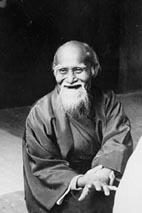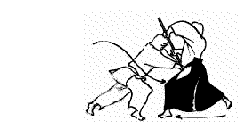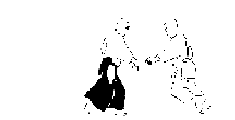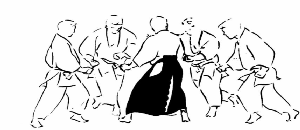



Ai - agreement, oneness, harmony Ki - environment, nature or spirit of the universe Do - road, path, or way of life

AIKIDO is a unique exercise introduced by Master Morihei Ueshiba (1883 - 1969) after having a thorough practice on Japanese bujutsu, for example aikijutsu, kenjutsu, and bojutsu, and realizing the essence of life.
 The Founder of Aikido, Master Morihei
Ueshiba
The Founder of Aikido, Master Morihei
Ueshiba
 |
AIKIDO |  |
Some experts say Aikido is a
martial art because it has martial arts techniques, for example, it has atemi
(dangerous blow), painful lock, and dangerous throw.
Some others say Aikido
is a unique martial art because it is directed to implement love and
harmony.
Aikido can be an extremely
effective tool for 'self-defence', and many people are attracted to the art for
that reason. Most people train, however, because of the vast difference it has
made in the quality of their lives. Increased health, happiness, personal
growth, greater acceptance of one's self and others, more and better
interaction/effectiveness in the world, friends and fellow seekers are all a
part of the Aikido experience and the primary motivation for continued
study.
Aikido is a unique method of self-defence, equally adaptable to and
effective against a single or several attackers.
The four principles of Aikido are: 
|
|
|
|
|
|
|
|
As well as the 'four basic principles for mind and body unification', there are a number of other sets of principles designed to help you in your training and Ki development.
Five principles for learning Ki:
Be flexible and open-minded.
Never tire of training or repeating fundamentals.
Be resourceful in applying Ki in your daily life.
Change your subconscious mind.
Learn it well enough to teach others.
You maintain a posture of mastery.
You have a sense of freedom.
You create an atmosphere of harmony.
You are vividly aware of the spirit of life in all things.
Therefore you can feel the movement of Ki in the universe.
Exhale gradually, with purpose and control.
Exhale with a distinct, but barely audible sound.
At the end of the breath, Ki continues infinitely like a fading note.
Inhale from the tip of the nose until the body is saturated with breath.
After inhaling, calm the mind infinitely at the one point.
Sit in seiza (or cross-legged with
a cushion underneath you in order to keep your spine straight). Adoption to
sitting in seiza should be built up gradually, increasing the time spent in this
position by a few minutes every session. Sit lightly, with your back straight
and shoulders relaxed so that the weight of your body falls naturally to your
one point.
Inhalation should be prolonged, as thin stream of air is drawn in
through the nostrils at a regular, controlled rate. The sound of such a
prolonged inhalation should be close to the letter 'u'. And this inhalation
should be done relaxedly with no straining. Moreover, even though the air is
drawn in through the nose, the glottis at the back of the throat should be used
to control the stream. By drawing the air in through contraction of the glottis,
instead of 'sniffing' the air, you will achieve a slow, steady stream.
The
air you inhale should not only fill the chest cavity, but also the lower
abdomen. Inhale deeply into the lower abdomen such that it expands normally,
without undue strain or tensing of your stomach muscles. The idea is to breathe
as fully and naturally as a child.
Keep your shoulders down and relaxed
during the inhalation. When you have inhaled all that you comfortably can, rest
quietly for a moment or so before beginning to exhale.
Exhale through the
mouth in a steady, concentrated, powerful (but relaxed) stream - the sound of
the exhalation resembles a 'haa'. Again, there should be no strain. Don't
attempt to exhale suddenly with great force.
Breathing exercises should be
practised daily. When combined with regular practice of the art of Aikido this
results in co-ordinated development.
Five principles for Ki exercises:
| 1.Ai-ki the root Of the power of
love, makes love grow Forevermore. The great universe Is itself the way of ai-ki A light for countless people That opens up the world. This beautiful form Of heaven and earth Is a single household Created by the guardian spirit. 2.Ai-ki is the power of
harmony, |
3. Attacking with a long
sword, The enemy thinks I'm in front of him. Ah, behind him, I'm already standing there. Even though surrounded By several enemies set to attack, Fight with the thought That they are but one. When entering a forest of spears And they encircle you, Remember, your mind Is your protective shield. With your right hand Showing 'yang', Your left hand showing 'yin', Lead your opponent. When the enemy comes Running to strike you, Step aside, avoid him, Immediately attack, and cut. Why do you fix your eyes On the swinging sword? His grip reveals Where he wants to cut. |
These three poems were written by the Founder of Aikido (Great Master Morihei Ueshiba). The first and the second poems explain that the heart of Aikido is harmony and love, and the third one (written long before the Founder decided that the heart of Aikido should be harmony and love) describes what to do in a life-or-death combat.
Principles of the Circle, Square and Triangle
"The body
should be triangular, the mind circular. The triangle represents the generation
of energy and is the most stable physical posture. The circle symbolises
serenity and perfection, the source of unlimited techniques. The square stands
for solidity, the basis of applied control."
--O Sensei--
O Sensei used these three principles to help his students better understand what they were learning. The Circle (marui), the Square (shikaku), and Triangle (sankaku) were used to illustrate the different concepts of movement and technique.
Triangle:  O
Sensei used the triangle to illustrate the idea of water flowing. He said that
water always take the path of the least resistance, and this is what an Aikidoka
should be doing as well. An example of a triangle movement would be the irimi,
or entering techniques. The triangle can be compared to the irimi (entering)
techniques because it gives the impression of direct movement, without a turn or
a Tai-sabaki, just a quick forward technique. Sometimes the direct responses to
an attack are very effective, and are excellent for unbalancing your
partner.
O
Sensei used the triangle to illustrate the idea of water flowing. He said that
water always take the path of the least resistance, and this is what an Aikidoka
should be doing as well. An example of a triangle movement would be the irimi,
or entering techniques. The triangle can be compared to the irimi (entering)
techniques because it gives the impression of direct movement, without a turn or
a Tai-sabaki, just a quick forward technique. Sometimes the direct responses to
an attack are very effective, and are excellent for unbalancing your
partner.
Circle:  Depending on your position and your opponent's balance, any technique
can be executed from both the inside and outside of your partner's body. The
circle comes from the Japanese word Ju, meaning soft or gentle. The concept of
Ju is the principle of pulling when pushed and pushing when pulled. We commonly
hear the phrase "fight fire with fire", but I always thought that, this was the
opposite of the philosophy of Aikido.The idea of the circle is to be like a
ball, rolling with the attacks, usually by executing a Tai-Sabaki to end up
beside the attack. Being beside it effectively paralyses the attack, because it
is very hard to hit someone who is beside you and that close. When fighting
directly, face to face, your opponent will have the opportunity to attack
multiple times. After the first attack, being a circle, you should be beside
him, but only for a moment, continuing his movement, yet still in control.
Before the initial momentum of the attack has been spent, either while he's
still committed to the strike, or as he's pulling back, recovering, this is the
time to act, leading that movement into a technique.
Depending on your position and your opponent's balance, any technique
can be executed from both the inside and outside of your partner's body. The
circle comes from the Japanese word Ju, meaning soft or gentle. The concept of
Ju is the principle of pulling when pushed and pushing when pulled. We commonly
hear the phrase "fight fire with fire", but I always thought that, this was the
opposite of the philosophy of Aikido.The idea of the circle is to be like a
ball, rolling with the attacks, usually by executing a Tai-Sabaki to end up
beside the attack. Being beside it effectively paralyses the attack, because it
is very hard to hit someone who is beside you and that close. When fighting
directly, face to face, your opponent will have the opportunity to attack
multiple times. After the first attack, being a circle, you should be beside
him, but only for a moment, continuing his movement, yet still in control.
Before the initial momentum of the attack has been spent, either while he's
still committed to the strike, or as he's pulling back, recovering, this is the
time to act, leading that movement into a technique.
Square:  But what if the attack is
neither forward nor backward?
But what if the attack is
neither forward nor backward?
When O Sensei drew a square, he often wrote the word go, meaning strength. He said that since a square was made up of four ninety-degree angles, the most effective strike would be at a ninety-degree angle. The square is a very stable, very strong position, but it is unlike the triangle and circle in that it lacks movement. We often start off in a "square" frame of mind, being very calm and neutral. From here, if an attack comes, we can be very ready, and turn into a triangle and counter by entering, or by becoming a circle, to harmonise with the attack and put him down that way.
A FEW WORDS ABOUT OUR DOJO